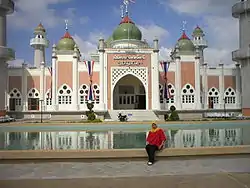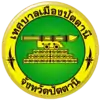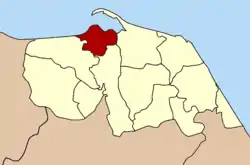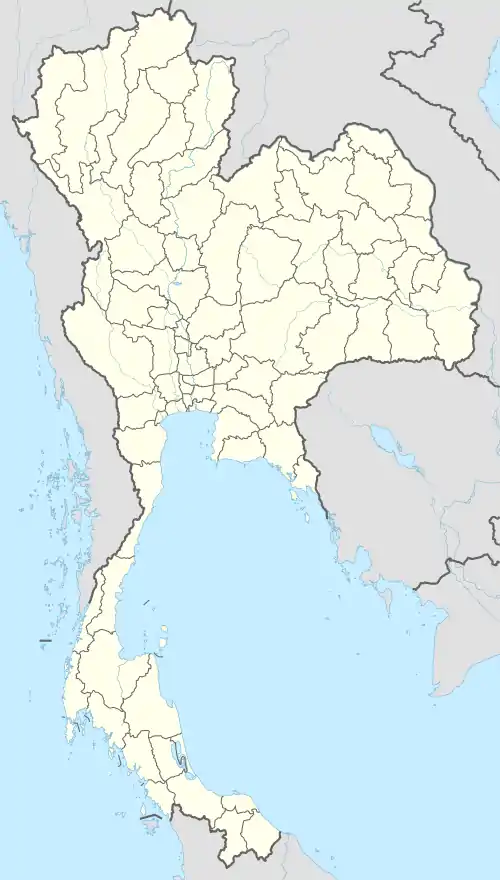Pattani, Thailand
Pattani is a town (thesaban mueang) in the far south of Thailand, near the border with Malaysia. It is the capital of Pattani Province. The city has a population of 44,353 (2018). It covers the whole tambon Sabarang, Anoru and Chabang Tiko of Mueang Pattani district.
Pattani
ปัตตานี | |
|---|---|
| เทศบาลเมืองปัตตานี | |
 Central Mosque of Pattani | |
 Seal | |
 Location in Pattani Province | |
 Pattani Location in Thailand | |
| Coordinates: 6°51′59″N 101°15′3″E | |
| Country | Thailand |
| Province | Pattani |
| District | Mueang Pattani |
| Government | |
| • Mayor | Pitak Korkiatpitak |
| Area | |
| • Town | 4.78 km2 (1.85 sq mi) |
| • Metro | 96.86 km2 (37.40 sq mi) |
| Population (2018) | |
| • Town | 44,353 |
| • Density | 9,300/km2 (24,000/sq mi) |
| Time zone | UTC+7 (ICT) |
| Area code | (+66) 73 |
| Website | pattanicity |
Pattani lies 1,056 km south of Bangkok,[1] and is located at the mouth of the Pattani River. A small port may have existed in the current location at Kuala Bekah by the early 17th century.[2] However, the older historical centre of the Pattani Kingdom that ruled over the region of Patani was located a few miles to the east of the present city; near Ban Kru Se or Kampong Kersik, which is where the Krue Se Mosque is located. The older Patani was captured and sacked by the Siamese in 1785, and a new town centre later developed in the current location and the Sultan moved to Cabang Tiga at the southern side of present-day Pattani in the 19th century.
The local dialect of Malay is called Patani Malay or Yawi in Thai (derived from Jawi).
Etymology
Some believe that the name Pattani originated from Malay name Patani (Jawi: ڤتنا), which can mean "this beach" in Patani Malay language. (In standard Malay, this would be pantai ini.) According to a legend, the founder of Patani was a raja from Kota Malikha named Phaya Tunakpa. Phaya Tunakpa went hunting one day and saw a beautiful albino mouse-deer the size of a goat, which then disappeared. He asked his men where the animal had gone, and they replied: "Pata ni lah!" ("This beach!" in the Patani Malay language). They searched for the mouse-deer but found instead an old couple, where the old man identified himself as Che' Tani ("Mister Tani"). The old man said that he was sent by the raja's grandfather to build a new town further beyond but had fallen ill on the journey; as he could not go any further, he stayed at that place. The raja then ordered a town be built at the site where the mouse-deer had disappeared. The town became Patani, which is believed to be named either after "this beach" where the mouse-deer had disappeared. Alternatively, it has also been said to be named after the old man as Pak Tani meaning "Father Tani".[3]
Some also say the word Pattani is derived from "Petani" in Malay which means "farmer". Another suggestion is that it derives from a Sanskrit word pathini, meaning "virgin nymph"; Pathini was the name of a daughter of Merong Mahawangsa, founder of the preceding Langkasuka Empire. [4]
Climate
Pattani has a tropical monsoon climate according to the Köppen climate classification, with a lengthy wet season and a brief dry season. The temperatures and humidity are high year round, with slightly higher temperatures in April, just as the monsoon arrives. The wet season is long, lasting April-December, and the dry season short, covering only January-March. The months of October, November, and December are particularly wet.
| Climate data for Pattani (1981–2010) | |||||||||||||
|---|---|---|---|---|---|---|---|---|---|---|---|---|---|
| Month | Jan | Feb | Mar | Apr | May | Jun | Jul | Aug | Sep | Oct | Nov | Dec | Year |
| Record high °C (°F) | 34.3 (93.7) |
35.9 (96.6) |
37.0 (98.6) |
37.9 (100.2) |
38.0 (100.4) |
36.6 (97.9) |
36.3 (97.3) |
35.8 (96.4) |
36.0 (96.8) |
35.0 (95.0) |
34.0 (93.2) |
33.9 (93.0) |
38.0 (100.4) |
| Average high °C (°F) | 30.7 (87.3) |
32.0 (89.6) |
33.2 (91.8) |
34.1 (93.4) |
33.8 (92.8) |
33.3 (91.9) |
33.0 (91.4) |
32.9 (91.2) |
32.4 (90.3) |
31.6 (88.9) |
30.2 (86.4) |
29.6 (85.3) |
32.2 (90.0) |
| Daily mean °C (°F) | 26.0 (78.8) |
26.5 (79.7) |
27.3 (81.1) |
28.2 (82.8) |
28.2 (82.8) |
27.9 (82.2) |
27.6 (81.7) |
27.5 (81.5) |
27.2 (81.0) |
26.9 (80.4) |
26.3 (79.3) |
25.9 (78.6) |
27.1 (80.8) |
| Average low °C (°F) | 22.3 (72.1) |
22.1 (71.8) |
22.7 (72.9) |
23.6 (74.5) |
24.2 (75.6) |
24.0 (75.2) |
23.7 (74.7) |
23.7 (74.7) |
23.6 (74.5) |
23.6 (74.5) |
23.5 (74.3) |
23.0 (73.4) |
23.3 (73.9) |
| Record low °C (°F) | 18.6 (65.5) |
16.7 (62.1) |
18.5 (65.3) |
17.4 (63.3) |
21.6 (70.9) |
20.6 (69.1) |
20.4 (68.7) |
21.0 (69.8) |
20.8 (69.4) |
21.3 (70.3) |
21.0 (69.8) |
19.7 (67.5) |
16.7 (62.1) |
| Average rainfall mm (inches) | 50.9 (2.00) |
32.0 (1.26) |
49.4 (1.94) |
74.6 (2.94) |
137.5 (5.41) |
109.4 (4.31) |
129.1 (5.08) |
134.0 (5.28) |
147.1 (5.79) |
216.2 (8.51) |
406.6 (16.01) |
378.3 (14.89) |
1,865.1 (73.43) |
| Average rainy days | 7.5 | 3.1 | 5.7 | 7.3 | 13.2 | 11.0 | 12.8 | 13.2 | 15.5 | 18.3 | 20.4 | 17.3 | 145.3 |
| Average relative humidity (%) | 81 | 79 | 79 | 78 | 80 | 80 | 80 | 80 | 81 | 84 | 86 | 85 | 81 |
| Mean monthly sunshine hours | 145.7 | 166.7 | 148.8 | 144.0 | 114.7 | 111.0 | 114.7 | 114.7 | 108.0 | 111.6 | 105.0 | 108.5 | 1,493.4 |
| Mean daily sunshine hours | 4.7 | 5.9 | 4.8 | 4.8 | 3.7 | 3.7 | 3.7 | 3.7 | 3.6 | 3.6 | 3.5 | 3.5 | 4.1 |
| Source 1: Thai Meteorological Department[5] | |||||||||||||
| Source 2: Office of Water Management and Hydrology, Royal Irrigation Department (sun and humidity)[6] | |||||||||||||
References
- "Distance: Bangkok to Pattani". Google Maps. Retrieved 22 May 2015.
- Bougas, Wayne (1990). "Patani in the Beginning of the XVII Century". Archipel. 39: 129, 136. doi:10.3406/arch.1990.2624.
- Wyatt, David K. (December 1967). "A Thai Version of Newbold's "Hikayat Patani"". Journal of the Malaysian Branch of the Royal Asiatic Society. 40 (2 (212)): 16–37. JSTOR 41491922.
- "{ms} Sejarah Malaysia - Asal Usul nama Sungai Petani". Sejarahmalaysia.pnm.my. Archived from the original on 2013-06-03. Retrieved 2012-08-24.
- "Climatological Data for the Period 1981–2010". Thai Meteorological Department. p. 26. Retrieved 8 August 2016.
- "ปริมาณการใช้น้ำของพืชอ้างอิงโดยวิธีของ Penman Monteith (Reference Crop Evapotranspiration by Penman Monteith)" (PDF) (in Thai). Office of Water Management and Hydrology, Royal Irrigation Department. p. 126. Retrieved 8 August 2016.